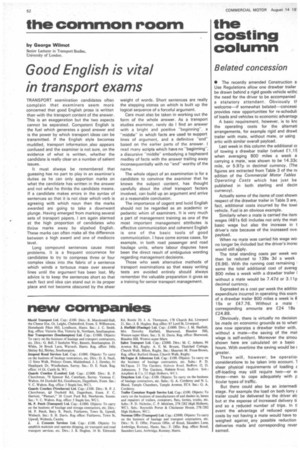the costing column
Page 54

If you've noticed an error in this article please click here to report it so we can fix it.
Belated concession
• The recently amended Construction a Use Regulations allow one drawbar trailer be drawn behind a rigid goods vehicle withc the need for the driver to be accompanied a statutory attendant. Obviously it welcome—if somewhat belated—concess1 provides new opportunities for re-scheduli of loads and vehicles to economic advantagi A basic requirement, however, is to knc the operating costs for the alternati arrangements, for example rigid and dravvt trailer with mate, without mate, or using attic with similar overall payload.
Last week in this column the additional cc of towing a drawbar trailer (valued £1,15 when averaging 800 miles a week a carrying a mate, was shown to be 14.33c mile, or 5.97p in decimal currency. (The figures are extracted from Table 3 of the m edition of the Commercial Motor Tables Operating Costs which has just be published in both sterling and decin currency).
Actually some of the items of cost shown respect of the drawbar trailer in Table 3 are, fact, additional costs incurred by the towi vehicle. Fuel is an obvious example.
Similarly when a mate is carried the item wages (481s 6d) includes not only the mat, basic wage but also the increase in t driver's rate because of the increased ovei payload.
When no mate was carried his wage wol no longer be included but the driver's increi would still aPply.
The total standing costs per week wo then be reduced to 139s 3d a week £6.96). With the running cost remaining I same the total additional cost of averag 800 miles a week with a drawbar trailer I without a mate would be 7,47d or 3.11p decimal currency.
Expressed as a cost per week the additio expenditure incurred in operating this exam of a drawbar trailer 800 miles a week is € 15s or £47.76. Without a mate I corresponding amounts are £24 lBs £24.88.
Obviously, there is virtually no decision be made on economic grounds as to whet one now operates a drawbar trailer with, without a mate—the saving of the mat wage is self-evident. Moreover the amou shown here are calculated on a basic hours. With overtime the saving would be $. greater.
There will, however, be operatioi considerations to be taken into account. 1 sheer physical requirements of loading E off-loading may still require two—or es three—men to cope adequately with p ticular types of traffic.
But there could also be an intermedi stage. For example the load on both lorry E trailer could be delivered by the driver alc but at the expense of increased delivery ti and so a !educed number of trips. In ti event the advantage of reduced operat costs by not having a mate would have to weighed against any possible reduction deliveries made and corresponding rever earned.




























































































